Lake Superior Kamloops
Kamloops fishery update: Kamloops stocking was discontinued in Minnesota tributaries to Lake Superior in 2018. To protect Lake Superior’s naturalized rainbow trout populations originating in Minnesota as well as steelhead within other jurisdictions, only genetically screened wild steelhead are now used as the gamete source to produce Minnesota’s hatchery-raised steelhead. These new hatchery steelhead are the replacements for Kamloops trout, are stocked in similar numbers in Lower North Shore tributaries to bolster fishing opportunities near Duluth, have a clipped adipose fin with a well-healed scar, and may be harvested according to regulations. please visit our Steelhead Genetics Project page for in-depth information on Kamloops and Steelhead genetics research.
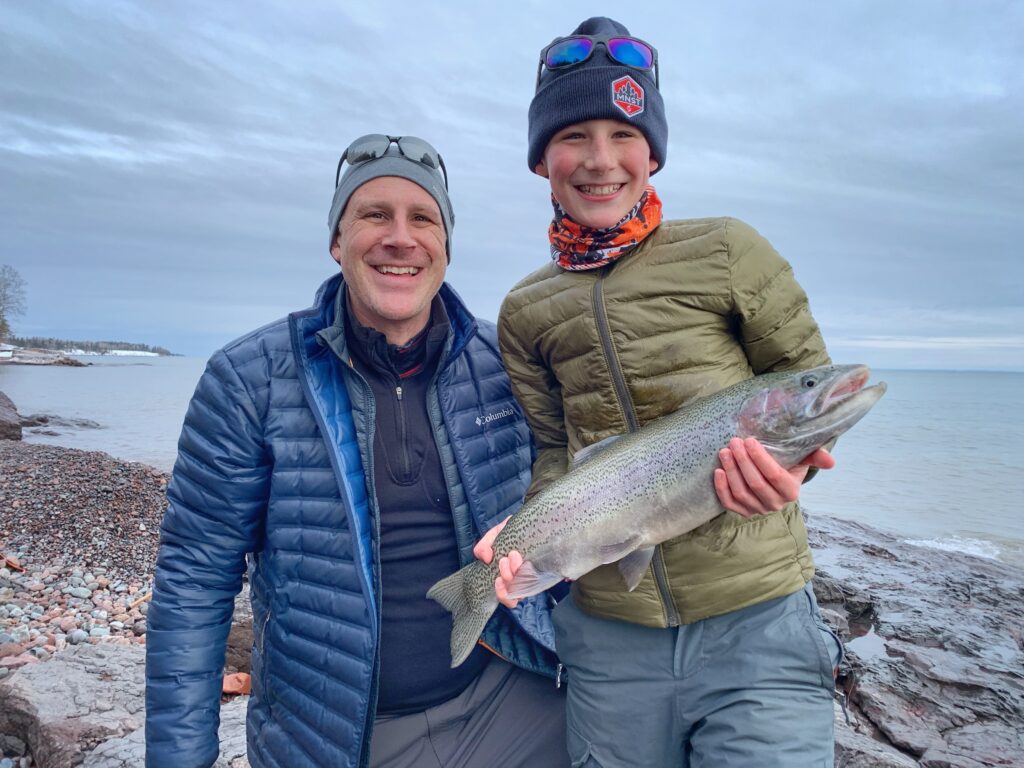
History: According to research, the Kamloops trout is more closely related to the rainbows & steelhead of California rather than those on British Columbia’s coast. It is now believed that these trout migrated to the Interior Region during glacial recession around 12,000 years ago. At that time, the Kamloops-Shuswap-Nicola region was covered by a vast glacial lake, which drained south to the Columbia River. It is believed the California rainbows migrated north via the Columbia, then settled in lakes across the Interior as the glacial melt water receded.
As the glacial bodies of water drained, separating & creating the present-day lakes of the region, different rainbow trout phenotypes -or Life-Form-Histories- evolved, and developed as a result of the varied and unique environmental influences present. Genetic analyses has shown that Kamloops previously stocked in Minnesota waters do not represent the pure form of Kamloops trout. They were as such referred to as a “Hatchery Strain.”
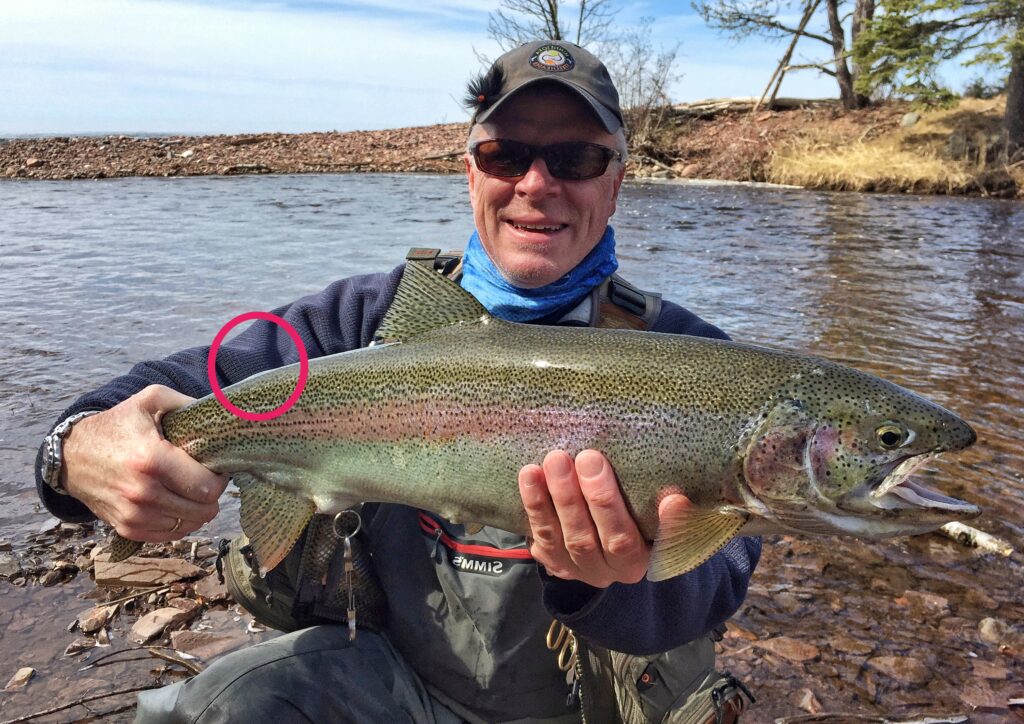

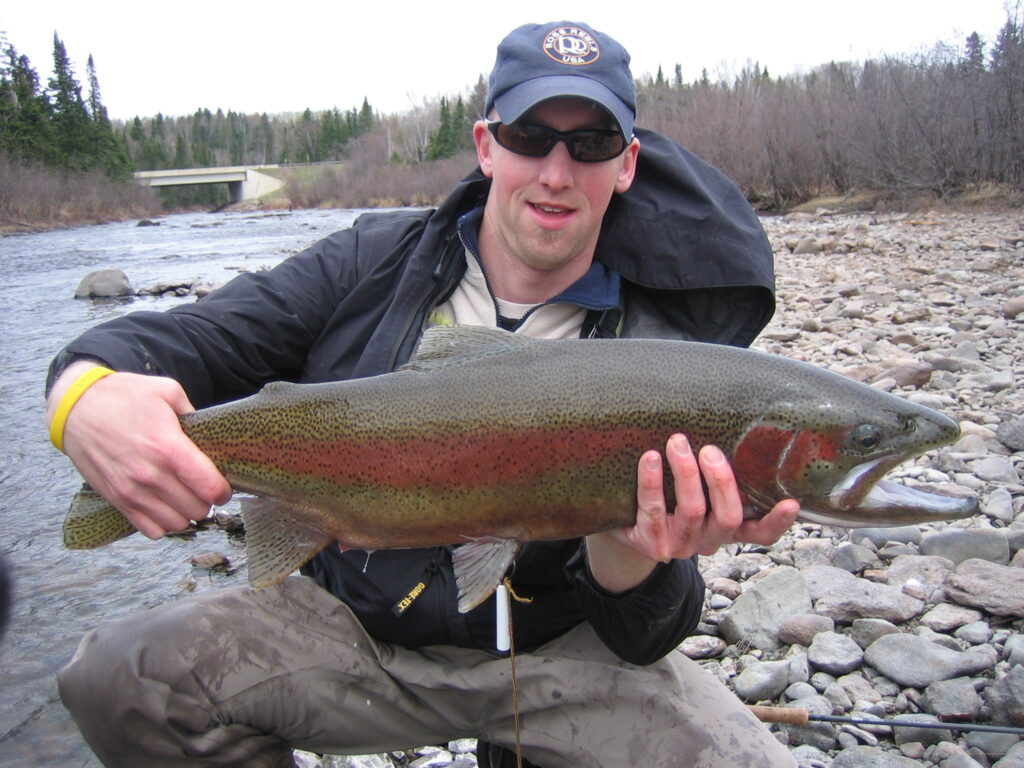
Minnesota: Starting in the 1970’s, experimental stocking of rainbow trout yearlings began in Minnesota as an attempt to augment wild steelhead stocks. In 1972 & 1973, three domestic strains of rainbow trout: Donaldson, Madison, & Kamloops, were stocked in Lake Superior to evaluate their respective performances. Study results indicated the Kamloops strain was best suited for a “put-grow-& take” fishery that could augment the growing harvest from the naturalized steelhead fishery.
In 1976, Minnesota began a Kamloops stocking program that established a put-grow-& take migratory rainbow trout fishery. This program evolved, and with the enactment of no-harvest regulations on wild steelhead under the Rainbow Trout Management Plan, Kamloops became the only rainbow strain that could be legally kept from the Minnesota waters and tributaries of Lake Superior.

Size: up to 30 inches & 9lbs., averaging 24- 26″ at spawning time in Minnesota waters
Identification: Stocky silvery body with a dull steel-blue to olive-green back. Heavy black spotting throughout the head, back, sides, adipose fin & tail. An Iridescent pink to reddish band extends from the head to the tail along the lateral line. White mouth & gums with well-developed teeth on the upper jaw & back of the tongue. Anal fin has 10-12 rays. Adipose fin was clipped in MN waters to aid in identification
Stocking: Kamloops stocking was discontinued in Minnesota after the 2016 year class was stocked in 2017. 2018 was the end of Minnesota’s Kamloops rainbow Trout stocking program. Kamloops were only stocked in Lower North Shore tributaries while the program was in operation. Confining stocking to the lower North Shore was, by design, done to reduce straying and to limit genetic introgression of Kamloops genes in wild steelhead stocks (cross-breeding). Kamloops x Steelhead crosses display a number of traits which limit their ability to survive from egg stage to adult. Straying after stocking was noted during the initial test period and was an area of concern from the beginning of the program. Tagged Minnesota Kamloops for example were recovered near Madeline Island in Wisconsin in 1974, and in the Au Sable River in Michigan in 1976.
Annual Minnesota creel censuses had also documented Kamloops straying, recording Kamloops from tributaries as far north as Hovland, Minnesota near the Canadian border. Genetic testing of scale samples through the Steelhead Genetics Project ultimately confirmed kamloops x steelhead cross-breeding. Numerous genetic simulation models were subsequently run predicated on varying levels of genetic introgression resulting from continued kamloops stocking. All models resulted in the demise of both steelhead and kamloops within 30 to 50 years. Finally, the Interstate Management Compact enforces “No Harm” provisions. If the Management and Programs of one State negatively impact another State, the Program must cease. The Minnesota Kamloops program was doing just that, and the Kamloops program was discontinued due to the combined reasons above.
Kamloops were formerly reared at the French River Hatchery, but rearing operations were ultimately moved to Spire Valley as a result of deteriorating infrastructure and the prohibitively high cost of French River hatchery rehabilitation. Adult Kamloops returning to the French River trap were used as the gamete source for the hatchery-reared fish. During the initial evaluation period, Kamloops were stocked in Trout Lake in Cook County & in the French River Estuary. Later stockings included Chester Creek, but after the adoption of the Lake Superior Management Plan, Kamloops stocking occurred in the following tributaries: French River – 35,000 yearlings annually (Summer); Lester River – 32,500 yearlings annually (Spring); Talmadge Creek – 25,000 yearlings annually (Summer)
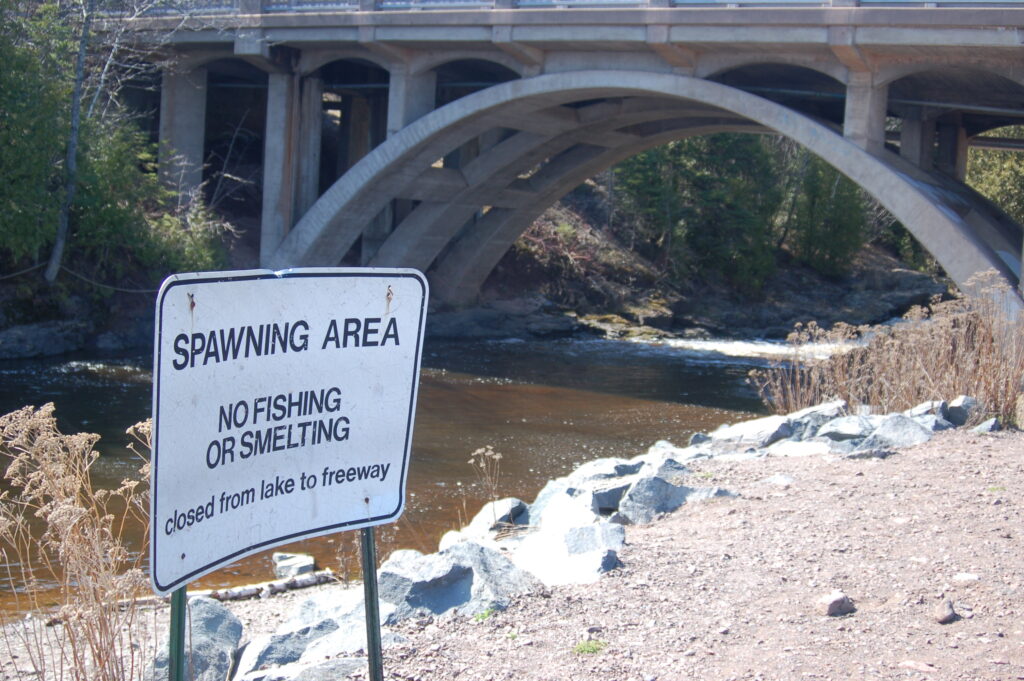
Spawning: Kamloops in Minnesota waters generally returned to the tributaries to spawn after 3 summers in the lake with the greatest numbers of adult fish returning at approximately age 5. Kamloops generally staged just offshore throughout the winter months providing a consistent, and very popular shore-fishery. They tended to enter the rivers just after ice-out, spawned at slightly lower water temperatures, and in lower stream reaches than steelhead. These traits combined to provide a somewhat earlier spring fishery than for steelhead.
Run activities historically peaked in mid-April at roughly the same time as steelhead, with spawning occurring at water temperatures in the upper 30’s to mid-40’s. Females scoop out a shallow depression in suitable gravel called a Redd, then deposit eggs which are fertilized by the male. After spawning, Kamloops returned to the lake although it is not known what the average time spent in streams was. Adult steelhead have been documented emigrating through the Knife River trap up to 60 days after initial capture, but it’s more likely both steelhead and kamloops spend around 14 days in streams on average.
Diet: Kamloops trout are primarily insectivorous (eating bugs) in their native range, but also piscivorous (eating fish). Aquatic insects such as: Dragonflies, Damselflies, Caddis, Sedge and Rail Flies comprised the bulk of kamloops stomach contents recorded in Minnesota DNR summer diet studies, along with lesser abundances of Chironomids (various Non-biting mosquito like flies). Fish comprised a minor portion of the Minnesota kamloops diet.
Common Name: Looper
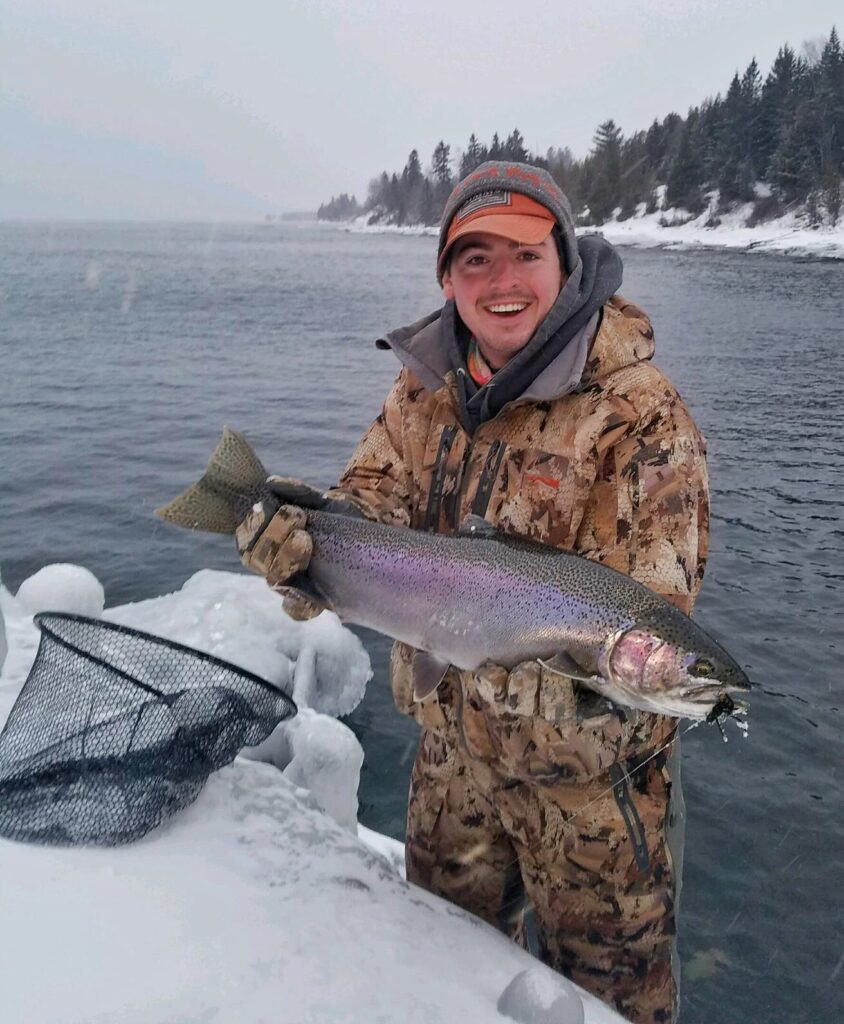
Fishing for Kamloops: Any remaining Kamloops are most often caught from the Gooseberry River south to the Duluth area tributaries, with an occasional strays caught further up the shore. These beefy Rainbows could be caught all year long and provided a very popular shore-fishery. On any given pleasant winter day, one could usually spot several hearty looper anglers scattered along the North Shore, wetting a line in the big lake. Most winter lake anglers float small jigs tipped with waxies, worms or spawn. The fly anglers are usually dead drifting spring wigglers, Superior X patterns, prince nymphs, egg flies, or some other sort of nymph pattern.
Some of the best shore fishing was from November through March although the majority of Kamloops were targeted during the spring run. Any remaining Kamloops trout run with the steelhead rainbow trout, and can be caught using the same gear, techniques and presentations. Both strains of Rainbow trout share the same pools, runs and eddies.
With five years of wild hatchery steelhead behind us as of 2023, the Kamloops replacements should begin to provide stream anglers with harvestable opportunities going forward. It is still unknown whether hatchery steelhead will provide the same high-quality nearshore fishery once provided by Kamloops.

Fisheries Management Plan for Minnesota Waters of Lake Superior
This plan is a comprehensive guide on how to best manage Minnesota’s portion of the Lake Superior fishery. The plan is written for use by both the MN DNR Fisheries Management Section and citizens interested in the management of Minnesota’s Lake Superior fishery resource. This plan is based on a fish community approach to fisheries management and highlights why this approach is necessary
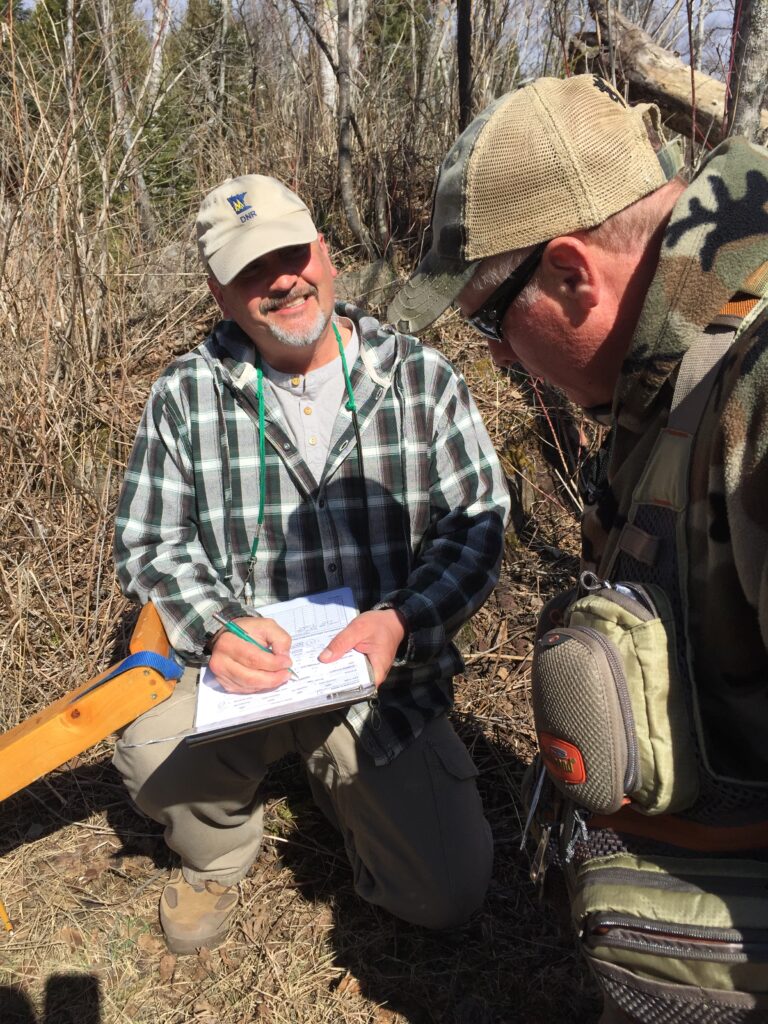
MN DNR Spring Creel Survey
The first spring creel survey was implemented in 1992 to monitor the rehabilitation of Rainbow Trout in Minnesota waters after the species declined in the 1960s. The survey was designed to target anglers who fished for Rainbow Trout as they migrated upstream in tributaries to spawn.
The annual spring creel survey typically begins once tributaries thaw and are fishable. The spring creel survey has provided useful information for many other species in Lake Superior. Brook Trout (Salvelinus fontinalis), one of two native sport fish to Lake Superior, are typically the second most reported species in the spring creel survey.
